Wavefront propagation using the SimEx Calculator “WavePropagator”¶
In this notebook, we will demonstrate how to propagate a simple Gaussian wavefront between two planes through vacuum. This is the simplest case of coherent wavefront propagation.
[1]:
%load_ext autoreload
[2]:
%autoreload 2
[3]:
# Import all SimEx modules
from SimEx.Calculators.WavePropagator import WavePropagator
from SimEx.Calculators.GaussianPhotonSource import GaussianPhotonSource
from SimEx.Parameters.WavePropagatorParameters import WavePropagatorParameters
from SimEx.Parameters.GaussWavefrontParameters import GaussWavefrontParameters
from SimEx.Utilities.Units import electronvolt, meter, joule, radian
import numpy
initializing ocelot...
Setup the initial wavefront¶
We first create a wavefront with a Gaussian intensity distribution. To this end, we use the GaussianPhotonSource Calculator and it’s corresponding parameter class, the GaussWavefrontParameters. Looking up the documentation of these two classes gives us the information needed to create the instances:
[4]:
GaussWavefrontParameters?
[5]:
GaussianPhotonSource?
We first describe the wavefront parameters which will then be used to create the wavefront itself:
[4]:
wavefront_parameters = GaussWavefrontParameters(photon_energy=8.0e3*electronvolt,
photon_energy_relative_bandwidth=1e-3,
beam_diameter_fwhm=1.0e-4*meter,
pulse_energy=2.0e-6*joule,
number_of_transverse_grid_points=400,
number_of_time_slices=12,
)
Now, we use the just created wavefront_parameters to initialize the Photon Source.
[5]:
photon_source = GaussianPhotonSource(wavefront_parameters, input_path="/dev/null", output_path="initial_wavefront.h5")
Let’s calculate the initial wavefront and visualize it:
[6]:
photon_source.backengine()
beam waist radius from divergence angle = 8.493e-05
beam waist radius from fwhm = 8.493e-05
We can retrieve the wavefront data from the calculator:
[7]:
wavefront = photon_source.data
Let’s visualize the wavefront using the WPG utilities.
[8]:
from wpg import wpg_uti_wf as wpg_utils
First plot the intensity distribution
[9]:
wpg_utils.plot_intensity_map(wavefront)
R-space
(400,) (400,)
FWHM in x = 1.019e-04 m.
FWHM in y = 1.019e-04 m.
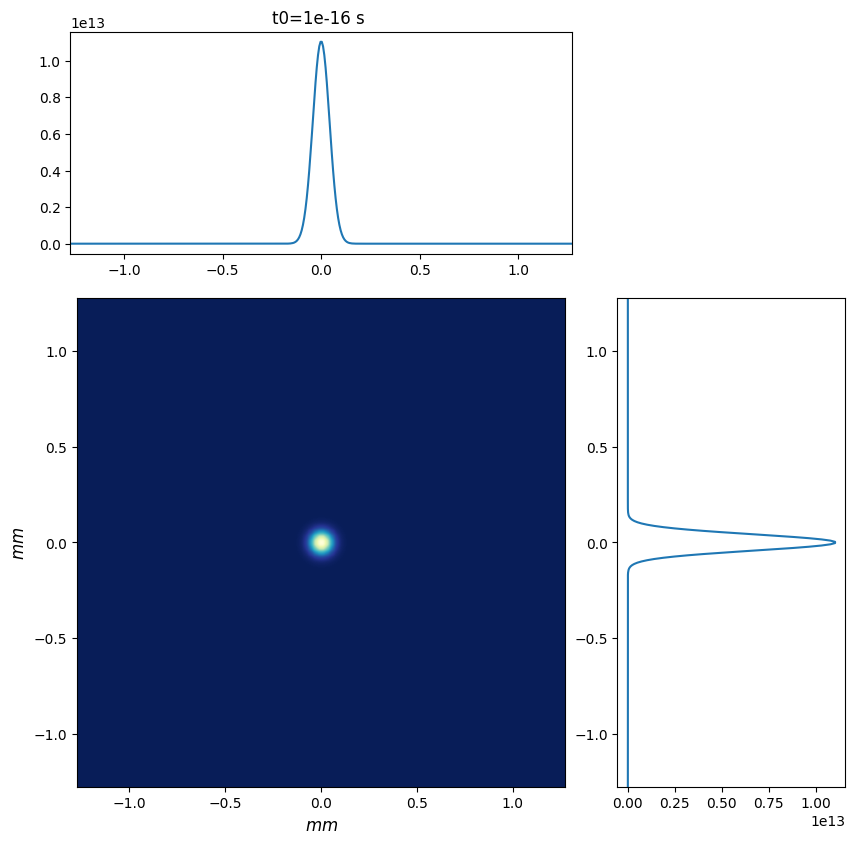
Plot intensity distribution in q-space¶
[10]:
wpg_utils.plot_intensity_qmap(wavefront)
Q-space
{'fwhm_x': 6.657123479604694e-07, 'fwhm_y': 6.657123479604694e-07}
Q-space
(400,) (400,)
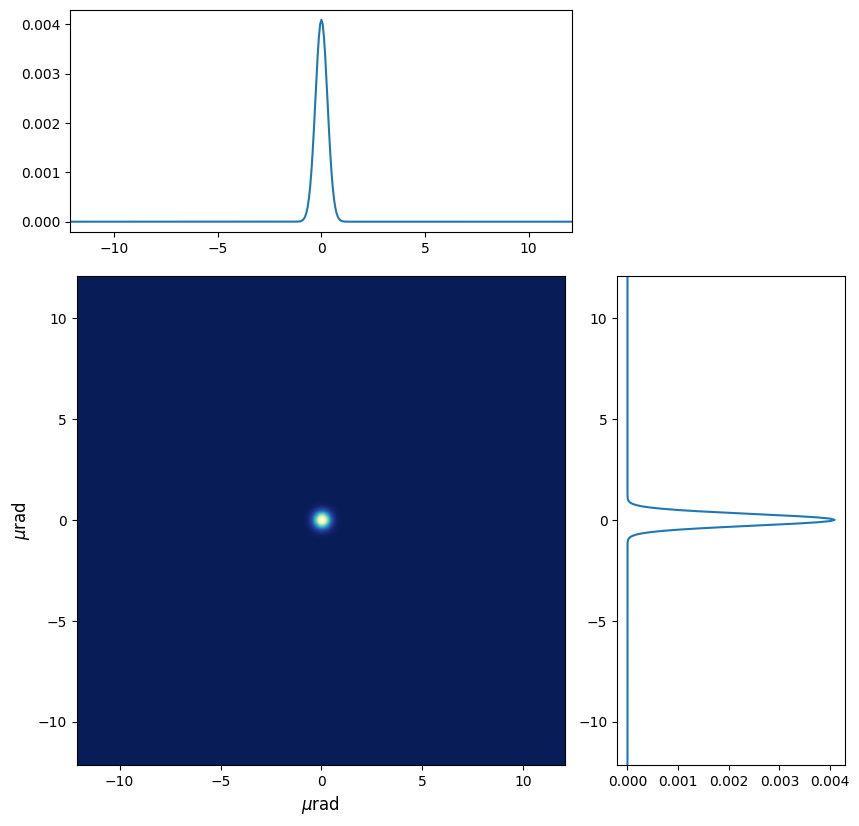
Plot the power as a function of time integrated over the transverse dimensions
[11]:
wpg_utils.integral_intensity(wavefront)
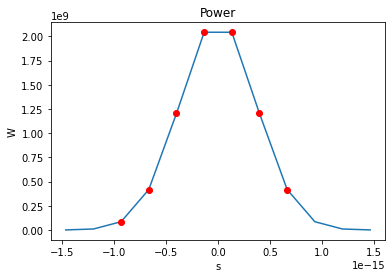
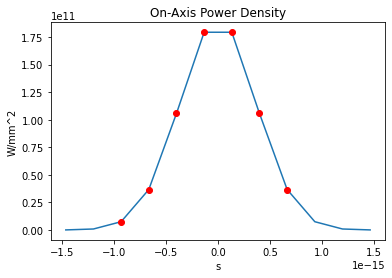
number of meaningful slices: 7
Pulse energy 2e-06 J
[11]:
1059337216.0
Plot the power spectrum
[12]:
import wpg
Check the sampling quality
[13]:
print(wpg_utils.check_sampling(wavefront))
WAVEFRONT SAMPLING REPORT
+----------+---------+---------+---------+---------+---------+---------+---------+
|x/y |FWHM |px |ROI |R |Fzone |px*7 |px*10 |
+----------+---------+---------+---------+---------+---------+---------+---------+
|Horizontal|1.019e-04|6.386e-06|2.548e-03|0.000e+00|0.000e+00|4.470e-05|6.386e-05|
|Vertical |1.019e-04|6.386e-06|2.548e-03|0.000e+00|0.000e+00|4.470e-05|6.386e-05|
+----------+---------+---------+---------+---------+---------+---------+---------+
Horizontal Fresnel zone extension NOT within [7,10]*pixel_width -> Check pixel width."
Vertical Fresnel zone extension NOT within [7,10]*pixel_height -> Check pixel width."
Horizontal ROI !> 3* FWHM(x) -> Increase ROI width (x).
Horizontal ROI !> 3* FWHM(y) -> Increase ROI height (y).
Focus sampling: FWHM > 10*px
END OF REPORT
Ok, we’re happy with our initial wavefront and will now proceed to setup the beamline. Our beamline will consist just of a stretch of vacuum over 10 m distance.
Estimate the beam size after 100 m propagation through empty space¶
Before we launch the numerical propagation machinery, let’s estimate the beam size to be expected after propagating through 10 m of vacuum.
The beam waist size (rms width of the E-field distribution, or distance from beam axis where intensity drops to \(1/e^2\) of its on-axis value) is given by the expression
$ w(z) = w_0 \sqrt{1 + \left(\frac{z}{R}\right)^2}`$, with the Rayleigh length :math:`R = \frac{\pi w_0^2}{\lambda}, \(\lambda\) is the central wavelength of the laser (ca,. 0.15 nm at 8 keV.)
Our Gaussian source distribution has a FWHM of \(10^{-4} m\). The FWHM and the beam waist radius as defined above are related to each other through \(\mathrm{FWHM}(z) = \sqrt{2 \ln 2} w(z) \simeq 1.177 w(z)\)
At \(z=100\,\mathrm{m}\), we therefore expect a FWHM of \(100\,\mu\mathrm{m}\cdot\sqrt{1.+\left(100/151\right)^2} \simeq 119.9 \mu\mathrm{m}\).
For numerical reasons, we have to set the radius of curvature to a finite value. Here we choose to set it to a value corresponding approximately to a distance of 1 m from the source position, \(z = 1\,\mathrm{m}\).
[14]:
wavefront.params.Rx = wavefront.params.Ry = 150**2
Setup the beamline¶
[21]:
from wpg import Beamline, optical_elements, srwlib
[16]:
beamline = Beamline()
[17]:
free_space = optical_elements.Drift(_L=100, _treat=1)
[18]:
free_space_propagation_parameters = optical_elements.Use_PP(semi_analytical_treatment=1)
[19]:
beamline.append(free_space, free_space_propagation_parameters)
[20]:
srwlib.srwl.SetRepresElecField(wavefront._srwl_wf, 'f')
beamline.propagate(wavefront)
srwlib.srwl.SetRepresElecField(wavefront._srwl_wf, 't')
[20]:
<wpg.srw.srwlib.SRWLWfr at 0x2b83161af750>
[22]:
wpg_utils.plot_intensity_map(wavefront)
R-space
(400,) (400,)
FWHM in x = 1.152e-04 m.
FWHM in y = 1.152e-04 m.
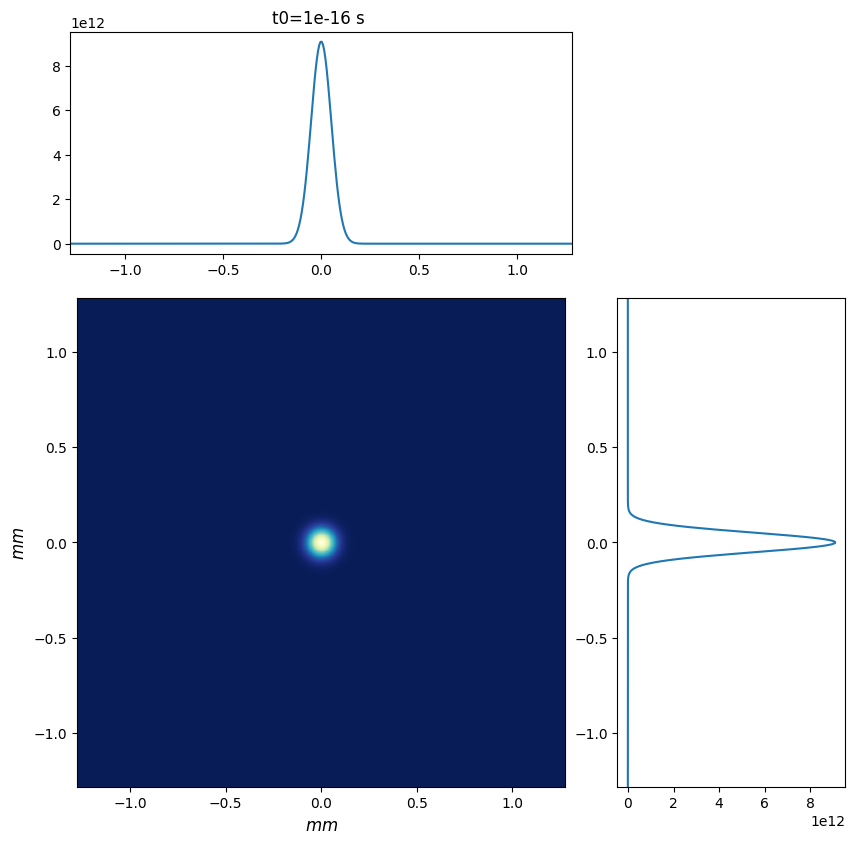
The result is \(\mathrm{FWHM} = 115.2\,\mathrm{\mu m}\) at \(z=100\,\mathrm{m}\). Considering that the FWHM is measured by counting pixels in the intensity profile, this is in rather good agreement with the analytical calculation above.